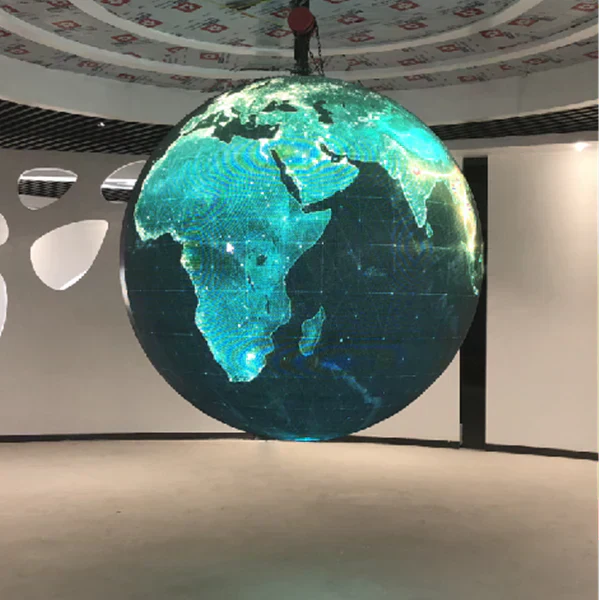With the rapid development of display technology, LED spherical screens have gained popularity for their unique 360-degree panoramic visual experience. These spherical displays are widely used in commercial spaces, exhibitions, museums, and large-scale events. Not only do they provide a distinctive visual effect, but they also add a sense of technology and art to any environment. However, different application scenarios impose different performance requirements, especially in terms of weatherproofing, brightness, heat dissipation, and material selection. Understanding the differences between indoor and outdoor LED spherical screens can help users make informed choices during selection and installation, ensuring both display quality and long-term reliability.
1. Special Requirements for Outdoor Environments
Outdoor LED spherical screens must withstand various environmental factors, including rain, dust, sunlight, and fluctuating temperature and humidity. These factors can directly affect the lifespan and performance stability of LED modules, power supplies, and the entire display system. Key design considerations for outdoor spheres include:
-
Waterproof and Dustproof Protection: Outdoor screens are exposed to rain, dust, and airborne debris, which can cause short circuits or module failures. Therefore, a high protection rating (such as IP65 or higher) is standard for outdoor displays. Proper sealing and protective housing prevent water and dust ingress, ensuring long-term reliable operation.
-
UV Resistance: Continuous exposure to sunlight can cause plastic components and coatings to fade, crack, or degrade. Outdoor spheres typically use UV-resistant coatings or weatherproof materials to delay aging and maintain their appearance over time.
-
Temperature and Humidity Tolerance: Outdoor environments experience wide temperature swings and high humidity, which can stress both materials and electronics. Using temperature-resistant and moisture-resistant components, along with proper ventilation and heat dissipation design, helps maintain stable performance under extreme conditions.
With these design considerations, outdoor LED spheres can deliver consistent brightness and performance in challenging environments, protecting the investment over time.
2. Importance of Materials and Sealing Design
Material selection and sealing design are critical factors that determine the weather resistance and durability of spherical screens. Differences between indoor and outdoor applications include:
-
Enclosure Materials: Outdoor spheres often use high-strength aluminum alloys, engineering plastics, or composite materials. These materials are lightweight yet provide corrosion resistance and impact protection. Indoor spheres, on the other hand, can use lighter materials since structural strength and weather resistance are less critical.
-
Sealing Components: Outdoor spheres typically include silicone or rubber gaskets to prevent water and dust from entering, protecting LED modules and power supplies. The seal must accommodate thermal expansion and structural deformation to maintain long-term effectiveness.
-
Weatherproof Coatings: Metal enclosures are usually coated with anti-corrosion or anti-oxidation layers to prevent surface aging caused by prolonged exposure to wind and sun. Indoor spheres may use simpler coatings since UV exposure and environmental wear are minimal.
By carefully choosing materials and sealing methods, spherical displays remain structurally robust while ensuring long-term reliability in various conditions.
3. Brightness and Visual Adaptation
LED spherical screen brightness is a crucial factor for achieving optimal display quality, with different scenarios requiring different levels:
-
Indoor Spheres: Indoor environments such as exhibitions, malls, or museums typically require 600–1000 nits for clear visibility. These screens prioritize color accuracy, high resolution, and visual comfort, minimizing glare and reflection.
-
Outdoor Spheres: To maintain visibility under direct sunlight, outdoor screens require higher brightness levels, often 4500–5000 nits or more. Outdoor displays also use anti-reflective treatments to improve visibility under strong lighting conditions.
Proper brightness and optical design enhance viewing experiences while reducing power consumption and prolonging LED module life.
4. Ventilation and Heat Dissipation Design
Heat management is vital for LED spherical screens, as excessive temperature can reduce brightness, alter color temperature, and damage modules:
-
Ventilation Design: Outdoor spheres need to balance waterproofing and heat dissipation. Hidden vents or water-tight fans are commonly used to allow heat escape while preventing water ingress.
-
Thermal Conductive Materials: Aluminum or thermal composite materials efficiently transfer heat from the LED modules to the enclosure, keeping chip temperatures low and maintaining stable brightness.
-
Temperature Control Systems: Large outdoor spheres often feature temperature sensors to dynamically adjust cooling systems, ensuring LED modules and power supplies operate safely for extended periods.
Although indoor spheres generate less heat, high-brightness or densely packed installations still require effective heat management to prevent localized overheating and maintain display quality.
5. Conclusion
LED spherical screens show clear differences between indoor and outdoor applications. Outdoor spheres emphasize waterproofing, dustproofing, UV resistance, temperature and humidity tolerance, high brightness, and efficient heat dissipation, whereas indoor spheres focus on lightweight construction, color performance, and ease of installation. Selecting the right type of spherical screen for the intended environment ensures maximum display effect, reliability, and return on investment.
Recommended LED Spherical Screens
|
Type |
Size / Pixel Pitch |
Product Link |
|
Small Indoor Sphere |
40–85 cm, P1.86–P2 |
|
|
Medium Indoor Sphere |
100–120 cm, P1.25–P2.5 |
|
|
Large Indoor Sphere |
150–200 cm, P1.25–P2.5 |
|
|
Giant Indoor Sphere |
200–500 cm, P1.25–P3 |
|
|
Medium Outdoor Sphere |
150–200 cm, P5–P6, Weatherproof |
|
|
Large Outdoor Sphere |
200–300 cm, P5–P6, Weatherproof |
|
|
Giant Outdoor Sphere |
400–1200 cm, P5, Weatherproof |
These spherical screens cater to diverse needs, from indoor exhibitions to large-scale outdoor commercial or public events, providing high brightness, weather resistance, and stable performance across various application scenarios.

